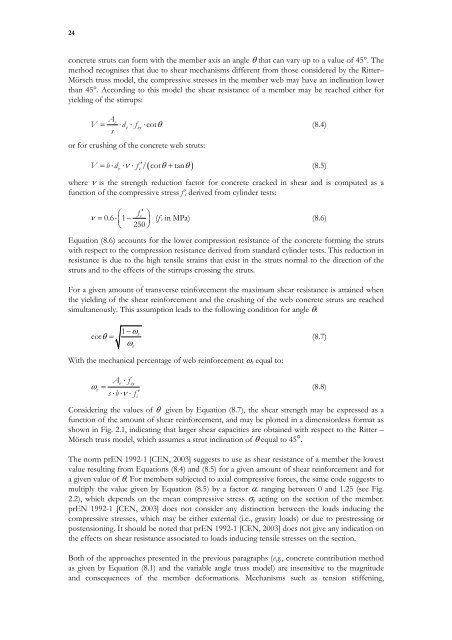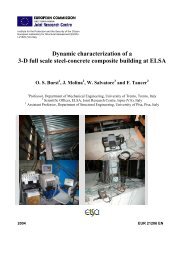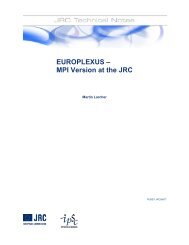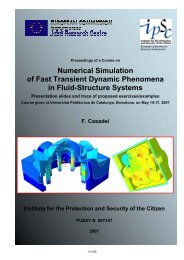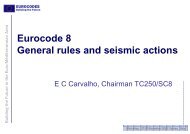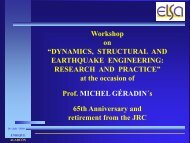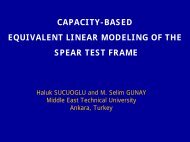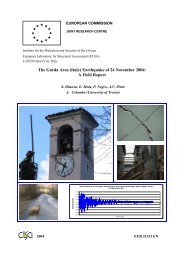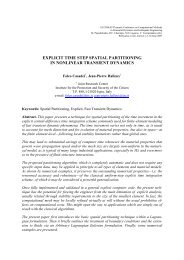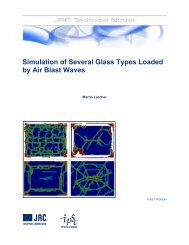239. TRUSS MODELSConsidering that the results obtained with the Ritter – Mörsch truss model underestimate theactual shear strength <strong>of</strong> rein<strong>for</strong>ced concrete members, most construction standard and norms (e.g.ACI 318–2002, CSA - Canadian Standard Association 1994) have accepted to add an empiricalcorrection term to the original truss equations. This term, known as the “concrete contribution”,and generally denoted as V c , is meant to represent those sources <strong>of</strong> shear resistance that the basictruss model is not able to capture. With this assumption, the nominal shear resistance can beexpressed as:V = V + V (8.1)scwhere V s represents the transverse rein<strong>for</strong>cement contribution to shear resistance. Thiscontribution is equal to Equation (7.1) in which f vy has been replaced by the tensile stress f v <strong>of</strong> thestirrups. The concrete contribution is taken as the shear <strong>for</strong>ce corresponding to the initiation <strong>of</strong>diagonal cracking, which has been assessed empirically from experimental data and may beexpressed from the following expressions as found in the ACI and CSA construction codes:⎛ P ⎞ACI 318 - 2002 Vc = 0.166⋅ 1 + ⋅ f ′ ⋅ ⋅⎜ ⋅ ⎟c b dv(MPa)⎝13.8 Ag⎠(8.2)CSA 1994 V = 0.20 ⋅ f ′ ⋅b⋅d(MPa) (8.3)c c vwhere f’ c is the compressive strength <strong>of</strong> concrete, b is the width <strong>of</strong> the member, d v is the effectivedepth <strong>of</strong> the member, A g is the gross area <strong>of</strong> the member section, and P is the axial load (positiveif compressive).When comparing Equation (8.2) and Equation (8.3), it is possible to observe that only the firstequation takes into account the effect <strong>of</strong> axial <strong>for</strong>ce on shear resistance: axial compressive loadsincrease the shear load at which flexural and inclined cracking occurs. The dependency <strong>of</strong> V c onthe axial load may be thought as a way to account <strong>for</strong> the effects <strong>of</strong> axial loads on the shearmechanisms neglected in the Ritter - Mörsch truss model, i.e., axial compression <strong>for</strong>ces generate alarger compression zone characterized by a greater shear strength; on the contrary, axial tensile<strong>for</strong>ces reduce the depth <strong>of</strong> the compression zone and may lead to premature yielding <strong>of</strong> thelongitudinal rein<strong>for</strong>cement, which in turn rapidly destroys the aggregate interlock mechanism. Itis worth noting that some codes (e.g. ACI 318-89) consider the beneficial effect <strong>of</strong> axial loads onshear resistance only <strong>for</strong> the case <strong>of</strong> axial <strong>for</strong>ces coming from external sources, such as gravityloads, while <strong>for</strong> axial <strong>for</strong>ces generated from self-equilibrated systems, no beneficial effects areconsidered.Acknowledging the conservative results given by the Ritter – Mörsch truss model, the EuropeanCode prEN 1992-1 [CEN, 2003] does not use the corrective term V c , instead adopts a methodknown as the “variable – angle truss method” 2 , which is based on a truss model in which the2 A combination <strong>of</strong> the variable-angle truss and a concrete contribution has also been proposed. Thisprocedure has been referred to as the modified truss model approach [CEB, 1978; Ramirez and Breen,1991]
24concrete struts can <strong>for</strong>m with the member axis an angle θ that can vary up to a value <strong>of</strong> 45°. Themethod recognises that due to shear mechanisms different from those considered by the Ritter–Mörsch truss model, the compressive stresses in the member web may have an inclination lowerthan 45°. According to this model the shear resistance <strong>of</strong> a member may be reached either <strong>for</strong>yielding <strong>of</strong> the stirrups:AvV = ⋅dv⋅ fvy⋅cotθ (8.4)sor <strong>for</strong> crushing <strong>of</strong> the concrete web struts:ν ′ ( θ θ)V = b⋅d ⋅ ⋅ f / cot + tan (8.5)vcwhere ν is the strength reduction factor <strong>for</strong> concrete cracked in shear and is computed as afunction <strong>of</strong> the compressive stress f’ c derived from cylinder tests:⎛ f ′ ⎞ν = 0.6⋅⎜1−c⎟ (f ’ c in MPa) (8.6)⎝ 250 ⎠Equation (8.6) accounts <strong>for</strong> the lower compression resistance <strong>of</strong> the concrete <strong>for</strong>ming the strutswith respect to the compression resistance derived from standard cylinder tests. This reduction inresistance is due to the high tensile strains that exist in the struts normal to the direction <strong>of</strong> thestruts and to the effects <strong>of</strong> the stirrups crossing the struts.For a given amount <strong>of</strong> transverse rein<strong>for</strong>cement the maximum shear resistance is attained whenthe yielding <strong>of</strong> the shear rein<strong>for</strong>cement and the crushing <strong>of</strong> the web concrete struts are reachedsimultaneously. This assumption leads to the following condition <strong>for</strong> angle θ:1−ωvcot θ = (8.7)ωvWith the mechanical percentage <strong>of</strong> web rein<strong>for</strong>cement ω v equal to:Av⋅ fvyωv=s⋅b⋅ν⋅ f ′cConsidering the values <strong>of</strong> θ given by Equation (8.7), the shear strength may be expressed as afunction <strong>of</strong> the amount <strong>of</strong> shear rein<strong>for</strong>cement, and may be plotted in a dimensionless <strong>for</strong>mat asshown in Fig. 2.1, indicating that larger shear capacities are obtained with respect to the Ritter –Mörsch truss model, which assumes a strut inclination <strong>of</strong> θ equal to 45°.The norm prEN 1992-1 [CEN, 2003] suggests to use as shear resistance <strong>of</strong> a member the lowestvalue resulting from Equations (8.4) and (8.5) <strong>for</strong> a given amount <strong>of</strong> shear rein<strong>for</strong>cement and <strong>for</strong>a given value <strong>of</strong> θ. For members subjected to axial compressive <strong>for</strong>ces, the same code suggests tomultiply the value given by Equation (8.5) by a factor α c ranging between 0 and 1.25 (see Fig.2.2), which depends on the mean compressive stress σ p acting on the section <strong>of</strong> the member.prEN 1992-1 [CEN, 2003] does not consider any distinction between the loads inducing thecompressive stresses, which may be either external (i.e., gravity loads) or due to prestressing orpostensioning. It should be noted that prEN 1992-1 [CEN, 2003] does not give any indication onthe effects on shear resistance associated to loads inducing tensile stresses on the section.Both <strong>of</strong> the approaches presented in the previous paragraphs (e.g., concrete contribution methodas given by Equation (8.1) and the variable angle truss model) are insensitive to the magnitudeand consequences <strong>of</strong> the member de<strong>for</strong>mations. Mechanisms such as tension stiffening,(8.8)
- Page 1 and 2: Simplified models/procedures forest
- Page 3 and 4: Simplifiedmodels/proceduresfor esti
- Page 6 and 7: iiiTABLE OF CONTENTSLIST OF TABLES
- Page 8 and 9: vLIST OF TABLESTable 1 Mechanical p
- Page 10 and 11: viiLIST OF FIGURESFigure 1 (a) Rein
- Page 13: xFigure 68 Average stress-strain re
- Page 17 and 18: xivν xywxyyA gA hA vCC sD= Shear s
- Page 20 and 21: 11. INTRODUCTIONA number of importa
- Page 22 and 23: 3On the basis of these results, it
- Page 24 and 25: 53. NUMERICAL MODEL3.1 GENERALITIES
- Page 26 and 27: 7⎛ 8 ⎞ ⎛ s ⎞ ⎛ s ⎞α =
- Page 28 and 29: 9less clear if the numerical model
- Page 30 and 31: 11longitudinal reinforcement ratio
- Page 32 and 33: 13where A c is the concrete gross s
- Page 34 and 35: 15where B and H are the section wid
- Page 36: 17whereξW2πE=dd(5.10)χ yLEd = μ
- Page 39 and 40: 20Another series of tests carried o
- Page 41: 22Rectangular case, section 2-2:F =
- Page 45 and 46: 269.1 PRIESTLEY ET AL. [1994]Accord
- Page 47 and 48: 28is given by Equation (7.1), the p
- Page 49 and 50: 30edges remain straight and paralle
- Page 51 and 52: 32of principal stresses in the conc
- Page 53 and 54: 34vci max0.18 ⋅ fc′=0.3 + 24
- Page 55 and 56: 36F = F + C − C(9.40)k k−1 k1 k
- Page 57 and 58: 38that there is a fundamental diffe
- Page 59 and 60: 40where α i defines the reinforcem
- Page 61 and 62: 42where⎡N( Ec3 −Ec2)⋅Δε⎤f
- Page 63 and 64: 44where1βt= (13.37)1 + 1.15 ⋅rec
- Page 65 and 66: 46• Acknowledging that hollow sec
- Page 67 and 68: 48Menegotto, M., Pinto, P.E. [1973]
- Page 69 and 70: 50CSA Committee A23.3 [1994] Design
- Page 71 and 72: 52Wong, Y.L., Paulay, T., Priestley
- Page 73 and 74: 54Table 4 Values of the parameters
- Page 75 and 76: 56Table 13 Values of factor α s de
- Page 77 and 78: 58PART BTable 23 Values of θ and
- Page 79 and 80: 60100800Displacement [mm]500-504000
- Page 81 and 82: 6260004000Moment [kN*m]20000-2000-4
- Page 83 and 84: 64NumericalExperimentalSlice #3Figu
- Page 85 and 86: 66NumericalExperimentalSlice #4Figu
- Page 87 and 88: 680.04 (3)0.03 (3)(3)1.20.02 (3)0.4
- Page 89 and 90: 702010 -2181614121, 2, 31, 2, 32 3
- Page 91 and 92: 72μ2018161412108642χ y* H10 -28.0
- Page 93 and 94:
7420181614121 to 51 to 510 -28.0x10
- Page 95 and 96:
762010 -2μ18161412108642031212 3 1
- Page 97 and 98:
78μ2018161412108642χ y* H10 -28.0
- Page 99 and 100:
80μ201816141 to 53214513to52χ y*
- Page 101 and 102:
82μ201816141210864203213213213211
- Page 103 and 104:
840.400.35ρ = 0.0050.400.35ρ = 0.
- Page 105 and 106:
86Compression chordPART B2PTransver
- Page 107 and 108:
88Figure 64 Contribution of axial f
- Page 109 and 110:
90Figure 70 (a) Calculated average
- Page 111 and 112:
92Figure 76 Hysteresis model for co
- Page 113:
The mission of the JRC is to provid


